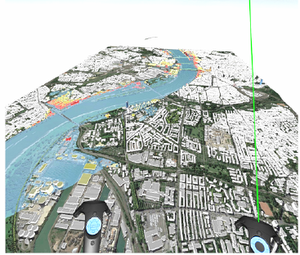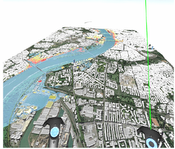Information
- Publication Type: Master Thesis
- Workgroup(s)/Project(s):
- Date: January 2019
- Date (Start): 6. July 2017
- Date (End): 23. January 2019
- TU Wien Library:
- Open Access: yes
- First Supervisor: Eduard Gröller

Abstract
In times of natural disasters like floods, the fast action of domain experts saves human lives and reduces high damages of the urban infrastructure. The training of different response plans of the responsible personnel should help in making the right decisions in time critical situations. As the creation of various physical training environments takes plenty of time, the use of virtual reality (VR) is a possible alternative. In recent years, different application domains with training purpose have been shifted to make use of the new developments in the field of VR. The desired benefits are a more flexible
generation of different realistic training environments with low budget and material
resources. Additionally, the VR application can serve as a public communication tool
to raise the sense of awareness. Based on these considerations, the aim of this work
is to create a VR training application to steer a remote flood simulation. The goal of the application is to provide a safe and realistic environment to train the responsible personnel. Through providing different scenarios, multiple flood events can be simulated and trained. The placement of barriers through interacting with the virtual environment offers possibilities to mitigate the results of the simulated floods. An Operator-Trainee setup enables the collaborative work between experts and trainees. While the expert works as an operator with a PC client, the trainee is able to perform instructions given
by the operator within the virtual environment. VR applications demand for high and steady frame rates as well as two high resolution images for both eyes to provide an immersive VR experience. Based on these conditions, appropriate PC hardware is needed to run a VR application in general. Additionally, high computational power is needed to perform the different flood simulations in a fast way. In order to achieve the performance requirements, the VR application is implemented within a client-server
architecture. The server is responsible for performing the flood simulation, while the
client deals with the VR-related tasks. These tasks comprise the visualization of the simulation data in VR and a fast and efficient processing of the data. In combination with a high performance rendering engine and graphic commands suitable for the given data, the desired performance can be achieved. As the feeling of immersion is highly depending on the provided frame rates, the evaluation of this first prototype is based on the achieved rendering performance. This is measured and evaluated based on two
different implementation strategies. Another important measurement is the update time of the water flow. A comparison of a CPU and a GPU implementation is presented
within the evaluation.
Additional Files and Images
Additional images and videos
Additional files
Weblinks
No further information available.
BibTeX
@mastersthesis{donabauer_2019_1,
title = "VR-Client for Scenario-based Response Training in Disaster
Management",
author = "Johanna Donabauer",
year = "2019",
abstract = "In times of natural disasters like floods, the fast action
of domain experts saves human lives and reduces high damages
of the urban infrastructure. The training of different
response plans of the responsible personnel should help in
making the right decisions in time critical situations. As
the creation of various physical training environments takes
plenty of time, the use of virtual reality (VR) is a
possible alternative. In recent years, different application
domains with training purpose have been shifted to make use
of the new developments in the field of VR. The desired
benefits are a more flexible generation of different
realistic training environments with low budget and material
resources. Additionally, the VR application can serve as a
public communication tool to raise the sense of awareness.
Based on these considerations, the aim of this work is to
create a VR training application to steer a remote flood
simulation. The goal of the application is to provide a safe
and realistic environment to train the responsible
personnel. Through providing different scenarios, multiple
flood events can be simulated and trained. The placement of
barriers through interacting with the virtual environment
offers possibilities to mitigate the results of the
simulated floods. An Operator-Trainee setup enables the
collaborative work between experts and trainees. While the
expert works as an operator with a PC client, the trainee is
able to perform instructions given by the operator within
the virtual environment. VR applications demand for high and
steady frame rates as well as two high resolution images for
both eyes to provide an immersive VR experience. Based on
these conditions, appropriate PC hardware is needed to run a
VR application in general. Additionally, high computational
power is needed to perform the different flood simulations
in a fast way. In order to achieve the performance
requirements, the VR application is implemented within a
client-server architecture. The server is responsible for
performing the flood simulation, while the client deals with
the VR-related tasks. These tasks comprise the visualization
of the simulation data in VR and a fast and efficient
processing of the data. In combination with a high
performance rendering engine and graphic commands suitable
for the given data, the desired performance can be achieved.
As the feeling of immersion is highly depending on the
provided frame rates, the evaluation of this first prototype
is based on the achieved rendering performance. This is
measured and evaluated based on two different implementation
strategies. Another important measurement is the update time
of the water flow. A comparison of a CPU and a GPU
implementation is presented within the evaluation.",
month = jan,
address = "Favoritenstrasse 9-11/E193-02, A-1040 Vienna, Austria",
school = "Research Unit of Computer Graphics, Institute of Visual
Computing and Human-Centered Technology, Faculty of
Informatics, TU Wien",
URL = "https://www.cg.tuwien.ac.at/research/publications/2019/donabauer_2019_1/",
}

 image
image Master thesis
Master thesis Poster
Poster


